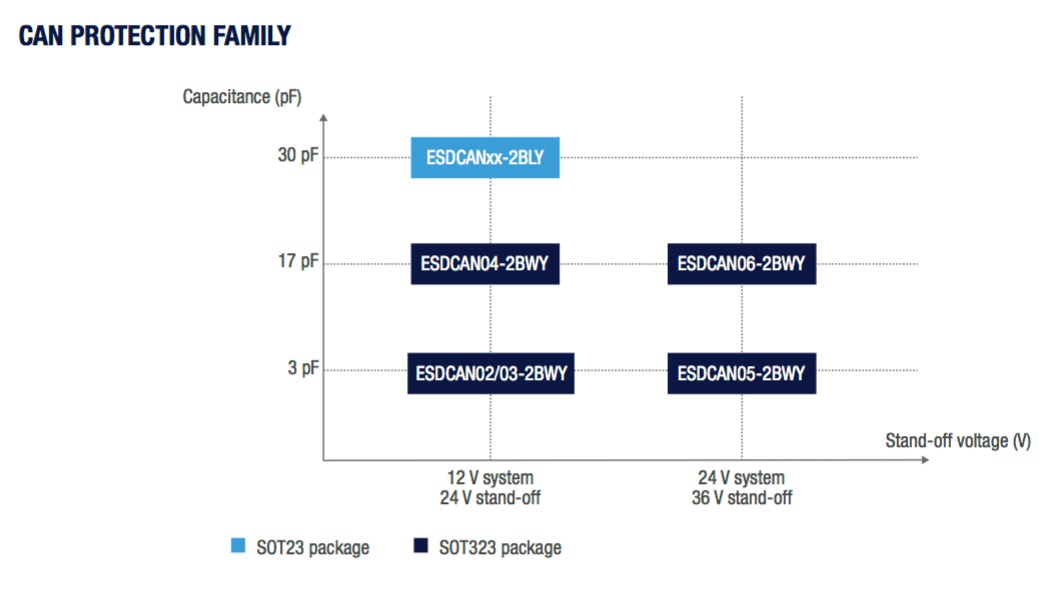STMicroelectronics’s experience includes designing and manufacturing components for the most hostile environments, including Mars itself. It was therefore natural for the company to come up with a comprehensive line of products aimed at protecting automotive circuits from their harsh surroundings. Any form of transportation must tolerate extreme temperatures, pressures, electrostatic and electromagnetic interferences. With the advent of autonomous and electrical vehicles, the circuits have greatly increased in complexity and sensitivity, thus demanding greater protection to prevent failures that could have catastrophic consequences.
CAN bus : the Heart of Safety Systems
One system that demands to be safeguarded from any form of malfunction is the CAN (Controller Area Network) bus. The protocol allows nodes to communicate among themselves directly without using a centralized master. The advantages of a CAN bus are many. It takes less wires to connect all the sensors and control units together, and the system can efficiently work with low-cost micro controllers. Every node can send or request information, and messages can easily be available to all nodes in the system. Hence, if a control fails, the rest of the system is still available, components can still talk to each other, they all receive the same messages, and can take immediate actions. The CAN bus also includes an error detection and correction scheme that ensures error-free communications, even in environments prone to interferences. In 2011, CAN-FD (Flexible Data-rate) updated the protocol to allow for faster transmission and longer data fields.

Because of its effectiveness, the CAN bus has increased in popularity over the years and is used in most forms of transportation, such as planes, trains, boats and, cars. In the latter, it is always used to wire safety systems together. The ABS, the transmission, the airbags, and many other components in charge of ensuring the safe and correct handling of a vehicle, are interconnected using the CAN bus. However, the components on a CAN node remain simple chips made out of semiconductors that are vulnerable to environmental hazards. However, a vehicle must function in highly charged environments and a controller area network cannot be disrupted because passengers brought cellphones and laptops. The heart of the safety features must be resilient if it is to its job.
STMicroelectronics at the heart of protecting the heart of safety systems
There are multiple ways, often used in conjunction, to protect CAN signal lines from electrostatic discharges or electromagnetic interferences. Manufacturers can include shielded twisted wires to prevent radiated interferences, and filters to attenuate the noise that could corrupt a message sent on the network. Finally, TVS (Transient Voltage Suppressor) modules absorb voltage spikes to ensure the components on a CAN function properly.
This is where STMicroelectronics’s expertise shines through in the form of a family of TVS that protects the CAN nodes from unexpected voltage spikes that result from electrostatic discharges (ESD). Among many others, the ESDCAN02-2BWY (stand-off voltage of 26.5 V and maximum pulse power of 250W), the ESDCAN03-2BWY (24 V / 230 W9), the ESDCAN01-2BLY (25 V / 230 W), the ESDCAN24-2BLY (27 V / 230 W) or the ESDAXLC6-1BT2Y for I/O ports, offer superior specifications than standards require. This means they are compliant with all the major interfaces used in automotive and can be easily added to a variety of designs to protect sensitive equipment up to 30 kV.
STMicroelectronics also offers protection against load-dump surges with their LDP01Y. A load-dump happens when the battery or charger is disconnected form a vehicle while in use. Load-dumps can cause very high peaks in voltages that can destroy components on the circuit if the spike is not properly dealt with. The LDP01Y family complies with all the major ISO and IEC standards to offer protection against voltage spikes of more than 100 Volts.
We often think of safety features in an a vehicle. STMicroelectronics has dedicated its expertise and knowledge to protect the heart of those safety features to ensure that it continues beating no matter the environment or circumstances it is in.

